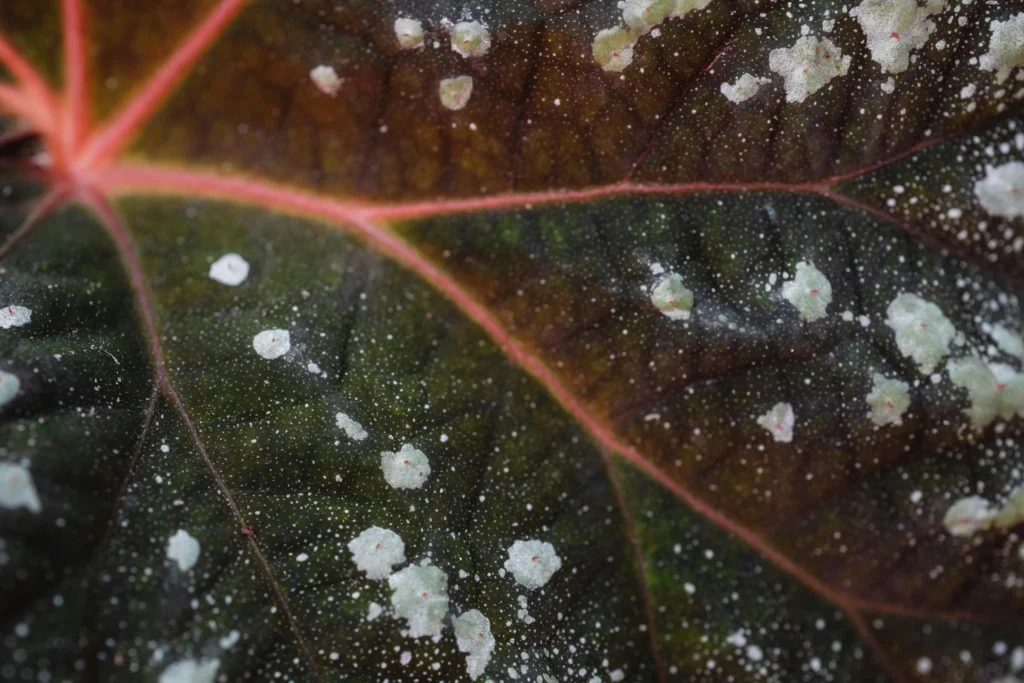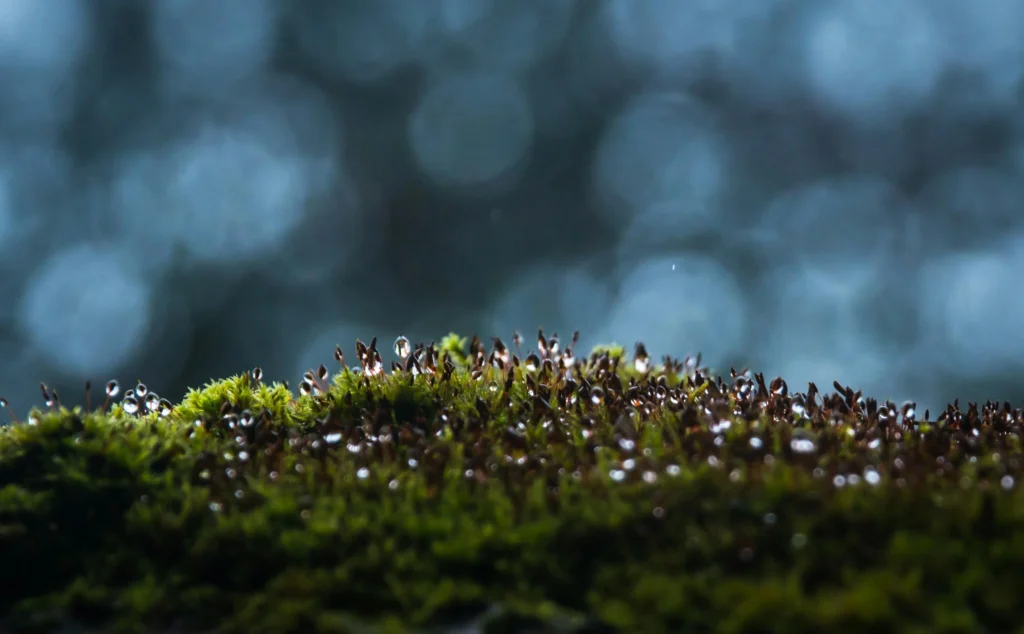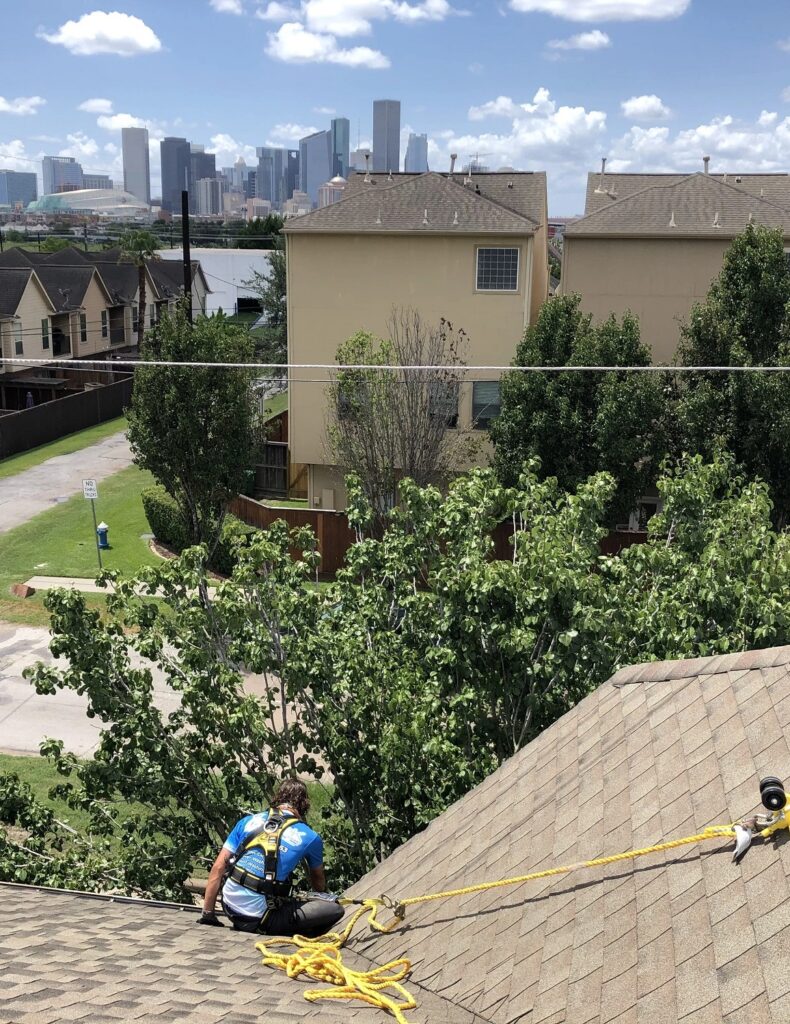How to Clean Asphalt Shingles
Your asphalt shingles have a tougher job than you might think. In Texas, where summer temperatures regularly soar past 100°F, these hardy warriors shield our homes from scorching sun, torrential rain, and everything in between. Yet according to the Asphalt Roofing Manufacturers Association, 80% of homes in America have asphalt shingle roofs that aren’t properly maintained – leading to repairs that could have been prevented.
Those dark streaks creeping across your roof? They’re not just cosmetic. Black algae, moss, and mold aren’t just unsightly – they’re actively eating away at your asphalt shingles. Let’s face it: replacing a roof in Texas can cost anywhere from $6,000 to $20,000. That’s why knowing how to clean an asphalt shingle roof correctly can help protect your investment and extend its lifespan.
But here’s the catch. Grab that pressure washer from your garage, and you might do more harm than good. Cleaning asphalt shingles requires a delicate touch and the right approach, which is why scheduling professional roof cleaning Austin services is highly recommended for long-lasting results. At Geek Window Cleaning, we’ve spent over 15 years providing expert roof cleaning Houston services, learning exactly what works (and what definitely doesn’t) to protect your roof.
Ready to learn how to keep your roof looking great while extending its lifespan? Let’s dive into everything you need to know about safely cleaning your asphalt shingles. Whether you’re planning to tackle this project yourself or considering professional help, this guide will help you make informed decisions about your roof’s care.
Understanding Your Roof’s Needs
Texas weather throws everything it’s got at our roofs. The intense heat, humidity, and sudden downpours create perfect conditions for organic growth on your shingles. In fact, our climate presents unique challenges that asphalt shingles in other regions don’t face. Our humid climate makes asphalt shingles particularly susceptible to three main issues:
- Algae growth: Thrives in our humid conditions, especially on north-facing roof sections
- Moss development: Common in shaded areas, particularly under tree canopies
- Dirt accumulation: Made worse by our frequent Saharan dust events and industrial pollution
Watch for these warning signs that indicate it’s time for a cleaning:
- Dark streaks or patches appearing on your roof
- Green or brown fuzzy growth in shaded areas
- Your asphalt shingles that appear darker than when installed
- Granules collecting in your gutters can signal damage to your shingles, so regular roof and gutter cleaning is essential to avoid costly repairs.
- Higher than usual energy bills in summer months
- Uneven coloring across your roof’s surface
- Visible dirt accumulation after rain
How to Clean Asphalt Shingles: The Basics
Understanding how to clean asphalt shingles properly involves more than just spraying down your roof—it’s about using the right technique to avoid damage. A methodical approach is crucial to ensure you’re cleaning your asphalt shingles without damaging them. Let’s break down the essential steps to get your roof looking fresh while preserving its lifespan.
Preparation Phase
Before you start, preparation is everything. Properly gathering your tools and taking safety precautions will not only make the job easier but also protect you from potential accidents. Here’s what you need to do:
- Gather all necessary tools and supplies: Make sure you have everything you’ll need on hand. This includes a specialized roof cleaner, a garden sprayer, a soft-bristled brush, and a leaf blower or broom for clearing debris.
- Wear safety equipment: Working on a roof can be dangerous. Equip yourself with non-slip shoes, a safety harness, gloves, and protective eyewear. These aren’t just optional—they’re essential for staying safe while you’re up there.
- Use proper ladder and roof safety equipment: A sturdy, properly positioned ladder is crucial. Make sure it’s set on stable ground, and consider using a ladder stabilizer to keep it steady against the roof. Always have a spotter if possible, especially if it’s your first time cleaning a roof.
Taking these preparatory steps ensures that you’re set up for success before you even start cleaning.
Thoroughly Soak and Cover All Plants and Vegetation
Your roof might be the main target, but it’s important to think about what’s below. Roof cleaning solutions can be harsh on your landscaping, so it’s crucial to protect any nearby plants:
- Use plastic sheeting or tarps: Cover any shrubs, flowers, and grass close to your house with plastic sheeting or tarps to protect them from potential chemical runoff. Make sure the covers are securely anchored to avoid wind displacement.
- Pay special attention to plants near the foundation: Plants closest to your home’s foundation are at the highest risk of exposure, especially when rinsing the roof. Soak the soil around these plants thoroughly with water before you begin. This helps dilute any cleaning solution that might drip down.
Initial Cleaning
Now that everything is set up, it’s time to clear your roof of any loose debris before applying any cleaning solutions. This step helps the cleaner work more effectively by ensuring it has direct contact with the asphalt shingles.
- Remove loose debris from the roof surface: Use a leaf blower or soft broom to gently clear off leaves, twigs, and any other loose material. Be mindful not to use too much force, as this could dislodge asphalt shingles or loosen granules.
- Clean gutters and downspouts: Before washing the roof, take the time to clear out your gutters or consider scheduling a professional gutter cleaning Austin service to ensure they’re properly maintained. This prevents blockages that could cause water and chemicals to pool, potentially damaging your roof and siding.
- Use a leaf blower or soft brush for stubborn debris: If you encounter areas where debris is stuck, a soft-bristled brush can help loosen it without damaging the asphalt shingles. The goal here is to remove as much surface material as possible before moving on to the chemical cleaning phase.
Chemical Treatment
Now comes the main event—applying a roof cleaning solution to tackle mold, mildew, algae, and moss. But it’s essential to do it correctly to avoid causing damage to your asphalt shingles.
- Apply the appropriate roof cleaning solution: For best results, consider using a specialized shingle cleaner to protect the integrity of your shingles. Be sure to follow the manufacturer’s instructions carefully, especially when it comes to dilution. Using too strong a solution can damage your asphalt shingles, while too weak won’t get the job done.
- Work in sections, starting from the top: Always start at the top of the roof and work your way down. This ensures that the cleaning solution can flow downward naturally, covering the roof evenly.
- Avoid over-saturating the shingles: Be mindful not to drench your roof excessively. Over-saturation can weaken asphalt shingles, especially if they are already old or brittle. Aim for a light but thorough coating.
Detail Work
After the initial application, it’s time to focus on the trouble spots. This is where you tackle those particularly stubborn areas that need extra attention.
- Focus on problem areas: Check for spots where algae, mold, or moss are more concentrated. These areas will often require a second pass to fully lift the stains.
- Address visible algae or moss growth: For patches where moss has taken root on your asphalt shingles, use a soft-bristled brush to gently dislodge it. Avoid scrubbing too hard, as aggressive motions can damage the asphalt shingles.
- Clean particularly dirty or stained sections: Some parts of your roof may be more weathered than others, especially if they get less sunlight. Use gentle, circular motions to work the cleaning solution into these sections.
- Use gentle scrubbing motions: Remember, asphalt shingles are durable but not invincible. Gentle scrubbing is key to avoid removing the protective granules that help your asphalt shingles last.
Post-Cleaning
The job isn’t done once the roof is clean. To wrap things up properly and ensure no damage to your property, follow these final steps:
- Thoroughly rinse plants and shrubs with clean water: Once you’ve finished cleaning the roof, remove the plastic sheeting and thoroughly rinse any exposed plants. This will wash away any stray chemicals that might have landed during the cleaning process.
- Remove all protective coverings: Carefully take down the tarps and plastic sheeting to avoid damaging your plants. Make sure there’s no remaining chemical residue.
- Flush soil around the foundation to dilute any cleaning solution: Take a garden hose and thoroughly soak the soil around your home’s foundation. This dilutes any residual chemicals that may have dripped down, protecting your soil and landscaping.
- Check gutters and downspouts again: After the cleaning process, inspect your gutters to ensure they’re clear of any debris that might have been dislodged. This prevents potential water damage down the line and ensures proper drainage.
Taking the time to properly clean your roof not only boosts your home’s curb appeal but also extends the life of your asphalt shingles. If this sounds like a bit too much to handle on your own, leave it to the experts. Geek Window Cleaning offers professional roof cleaning services that safely remove dirt, moss, and algae without damaging your shingles. Reach out today to schedule your roof’s refresh!
How to Clean Mold and Mildew Off Asphalt Roof Shingles
Identifying Mold vs. Mildew
Mold and mildew may seem like they’re the same, but they have distinct characteristics. Mold often appears in darker shades—think black, green, or even blue. It penetrates deeply into asphalt shingles, potentially causing long-term structural damage if ignored. Mildew, on the other hand, tends to stay on the surface and appears as a gray or white powdery substance. Both are harmful, but mold is usually the bigger threat to your roof’s lifespan.
Safe Removal Techniques
If you’re wondering how to clean mold off asphalt roof shingles, using a soft washing technique is the safest way to protect the surface. Unlike pressure washing, which can strip away the protective granules on your shingles, soft washing uses a low-pressure spray combined with cleaning agents to gently remove mold without causing damage.
A commonly used cleaning solution is a mix of sodium hypochlorite (bleach), water, and a bit of detergent. To safely apply this solution:
- Mix one part bleach to three parts water in a sprayer.
- Spray the affected areas generously, ensuring even coverage.
- Allow the solution to sit for 10-15 minutes, but avoid letting it dry completely.
- Rinse thoroughly with a garden hose on low pressure.
This method will kill mold spores and prevent them from growing back for a while. However, avoid using harsh chemicals if you have nearby plants, as they can damage landscaping.
Prevention Strategies
Once your roof is mold-free, you’ll want to keep it that way. Installing zinc or copper strips along your roof ridge can help prevent mold growth. When rainwater hits these strips, it creates a natural fungicide that keeps mold and mildew at bay. Additionally, ensuring good airflow by trimming overhanging tree branches will reduce moisture buildup.
How to Clean Moss from Asphalt Shingles Safely
Moss presents a significant challenge for homeowners in Texas, particularly in areas with mature tree coverage such as West Lake Hills and The Woodlands. Unlike algae, which remains on the surface, moss has root-like structures that can penetrate shingles, lifting them and creating potential entry points for water. There have been instances where unchecked moss growth resulted in the costly replacement of entire sections of roofs—a valuable lesson in the importance of prevention.
So, what makes roofs so appealing to moss? Several factors contribute to its thriving conditions:
- Dense tree coverage, which provides ample shade.
- North-facing roof sections that receive less sunlight.
- Poor ventilation between trees and the roof surface.
- Accumulated organic debris that retains moisture.
- Regular morning dew or condensation that creates a damp environment.
Proper Removal Methods
To remove moss safely, avoid the temptation to scrape it off with a tool, as this can damage your shingles. Instead:
- Start by using a soft bristle brush to gently loosen the moss. Always work downwards to prevent lifting the shingles.
- Apply an oxygen-based cleaner, which is less harsh than bleach but just as effective at killing moss. Let it sit for about 20 minutes to penetrate the moss.
- Use a garden hose with low water pressure to rinse away the moss and cleaner.
This method is gentle enough to avoid damage while effectively removing moss. Remember, using high-pressure water can erode the protective granules on your shingles, so stick to a low-pressure rinse.
Prevention Tips
The best way to keep moss from returning is to address the root causes. Trim back any trees or shrubs that provide shade to your roof. Consider applying a moss-resistant treatment after cleaning, which will create a barrier to stop moss spores from taking root again. Regular roof inspections can also catch moss early before it becomes a bigger issue.
How to Clean Black Streaks Off Asphalt Shingles
What Causes Black Streaks
Those unsightly black streaks you see on your roof aren’t just dirt. They’re actually caused by Gloeocapsa magma, a type of airborne algae that thrives in humid climates like Texas. This algae feeds on the limestone filler in asphalt shingles, gradually wearing them down and reducing their effectiveness. The result? A roof that not only looks bad but also doesn’t perform as well in protecting your home from the elements.
Effective Cleaning Solutions
The most effective way to remove black streaks is through a soft wash combined with a gentle yet powerful algae remover. Here’s how to do it:
- Mix a cleaning solution using water, bleach, and trisodium phosphate. Use a ratio of one part bleach to three parts water for optimal results.
- Apply the solution with a sprayer, making sure to coat the entire surface evenly.
- Allow the solution to sit for about 10 minutes before rinsing it off thoroughly, top to bottom, with a garden hose.
By using a soft washing technique, you can remove the algae without stripping away the protective layer of your shingles. This not only restores the look of your roof but also helps it last longer.
Long-Term Prevention
To keep those black streaks from coming back, consider installing copper or zinc strips along the roof’s ridge. As rainwater flows over these strips, it creates a mild solution that inhibits algae growth. Additionally, scheduling a bi-annual roof cleaning can help keep your roof in pristine condition.
Professional Cleaning Methods for Asphalt Shingle Roofs
The difference between professional cleaning and DIY often comes down to three factors: equipment, expertise, and efficiency. Let’s break down the professional approach:
Soft Washing vs. Pressure Washing:
- Soft Washing:
- Uses low pressure (under 100 PSI)
- Relies on chemical cleaning action
- Protects shingle granules
- Provides longer-lasting results
- Pressure Washing (NOT Recommended):
- Can strip granules
- May void warranties
- Creates risk of water infiltration
- Provides only temporary results
Professional Equipment Checklist:
- Commercial-grade soft wash systems
- Professional-strength cleaning solutions
- Safety harnesses and roof anchors
- Specialized application nozzles
- Surface temperature monitors
- Chemical dilution systems
Safety and Best Practices
Required Safety Equipment
Roof cleaning is not without its risks, especially if your roof has a steep pitch or you’re not comfortable with heights. Always wear personal protective equipment (PPE), including a safety harness, non-slip shoes, gloves, and protective eyewear.
Weather Considerations
The best time to clean your roof is on a dry, overcast day. You want to avoid direct sunlight, which can cause cleaning solutions to evaporate too quickly. Windy days are also a no-go since they can blow chemicals into unwanted areas, including your garden or pool.
When to Avoid DIY Cleaning
If your roof is particularly steep, you have extensive moss or algae growth, or you’re simply not comfortable working at heights, leave it to professionals. Geek Window Cleaning is fully equipped to handle these challenges safely and effectively.
Maintaining Your Clean Roof
Preventative Measures
Once your roof is clean, you’ll want to keep it that way. Trim back any trees that might be shading your roof, clean your gutters regularly, and check for debris after storms. This will help reduce moisture buildup, which can lead to algae and moss growth.
Regular Maintenance Schedule
Schedule a professional roof cleaning every 2-3 years. This ensures that your roof stays in good condition, prolongs its lifespan, and prevents minor issues from turning into major headaches. Additionally, routine inspections can help spot potential problems before they cause significant damage.
When to Call a Professional
If you notice widespread staining, moss growth, or if your asphalt shingles appear to be lifting, it’s best to call in the experts. Geek Window Cleaning offers comprehensive roof cleaning services tailored to your home’s needs, ensuring your roof remains in peak condition.
How to Clean Asphalt Shingles Without Damaging Them: conclusion
Your roof is one of your home’s most valuable assets, and regular maintenance is the key to protecting it. By keeping your shingles clean, removing moss, algae, and debris, and taking preventative measures, you can extend the life of your roof, improve your home’s curb appeal, and avoid costly repairs down the line. But roof cleaning can be tricky and dangerous if you’re not experienced.
Don’t wait for visible damage to take action—stay proactive! At Geek Window Cleaning, we provide expert roof washing services designed to safely and effectively restore your roof’s appearance and longevity. Contact us today for a free roof inspection and consultation. For Houston homes, call (713) 581-4963, and for Austin properties, reach out at (512) 270-7555. Let’s keep your roof in peak condition together!





Recent Comments